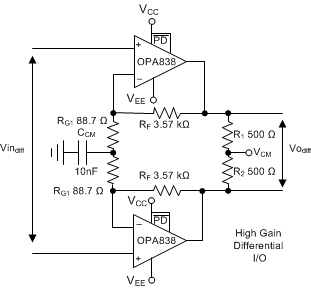JAJSDO2C August 2017 – October 2023 OPA838
PRODUCTION DATA
- 1
- 1 特長
- 2 アプリケーション
- 3 概要
- 4 Revision History
- 5 Device Comparison Table
- 6 Pin Configuration and Functions
-
7 Specifications
- 7.1 Absolute Maximum Ratings
- 7.2 ESD Ratings
- 7.3 Recommended Operating Conditions
- 7.4 Thermal Information
- 7.5 Electrical Characteristics: VS = 5 V
- 7.6 Electrical Characteristics: VS = 3 V
- 7.7 Typical Characteristics: VS = 5 V
- 7.8 Typical Characteristics: VS = 3 V
- 7.9 Typical Characteristics: Over Supply Range
- 8 Detailed Description
- 9 Application and Implementation
- 10Device and Documentation Support
- Mechanical, Packaging, and Orderable Information
パッケージ・オプション
メカニカル・データ(パッケージ|ピン)
サーマルパッド・メカニカル・データ
発注情報
9.2.1 High-Gain Differential I/O Designs
A high-gain differential-to-differential I/O circuit can be used to drive a second-stage FDA or a differential-to-single-ended stage. This circuit is frequently used in applications where high input impedance is required (for example, if the source cannot be loaded). Figure 9-3 illustrates an example design where the differential gain is 41 V/V. An added element between the two RG resistors increases the noise gain for the common-mode feedback. Make sure to provision for the added element; otherwise, a decompensated VFA (such as the OPA838) often oscillates. With only the RG elements in the differential I/O design, the common-mode feedback is unity-gain and often causes high-frequency, common-mode oscillations. To resolve this issue, split the RG elements in half and add a low-impedance path, such as a capacitor or a DC reference, between the two RG values.
 Figure 9-4 High-Gain Differential I/O Stage
Figure 9-4 High-Gain Differential I/O StageIntegrated results are available, but the OPA838 provides a low-power, high-frequency result. For best CMRR performance, match the resistors. A good rule is CMRR is approximately equal to the resistor tolerance; therefore, a 0.1% tolerance provides approximately 60-dB CMRR.